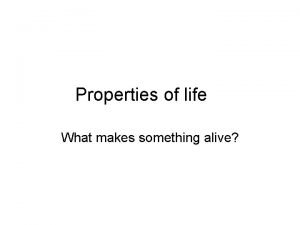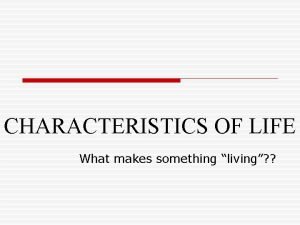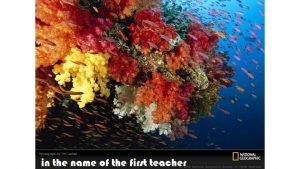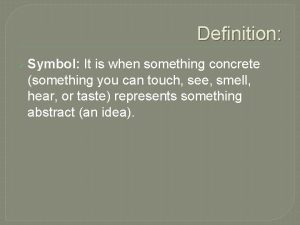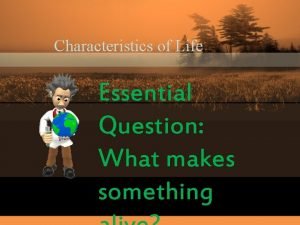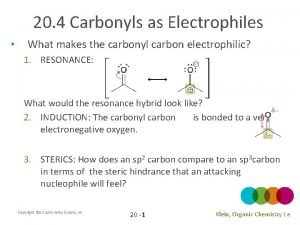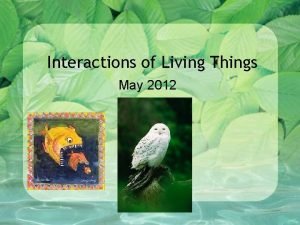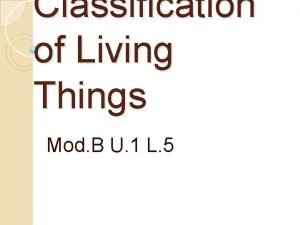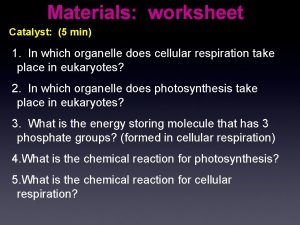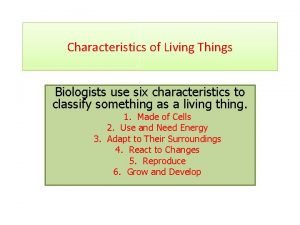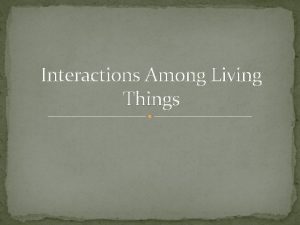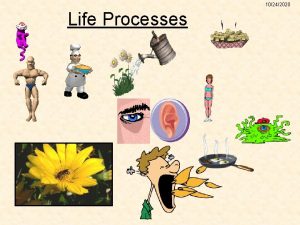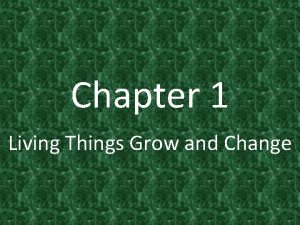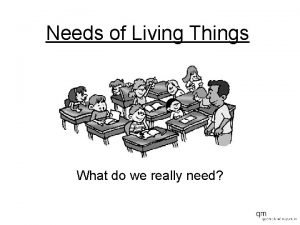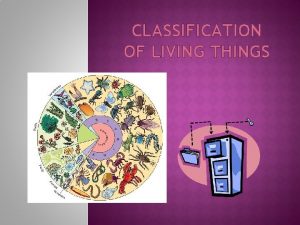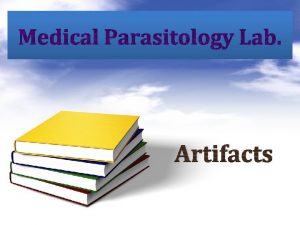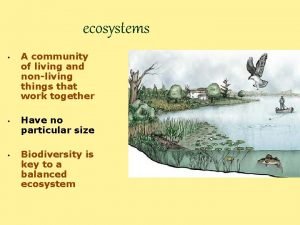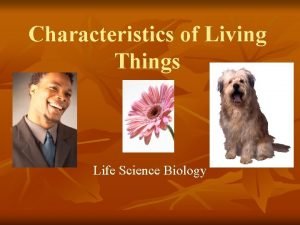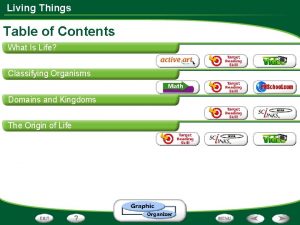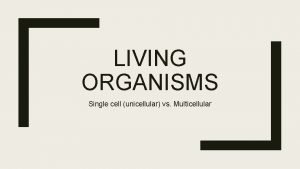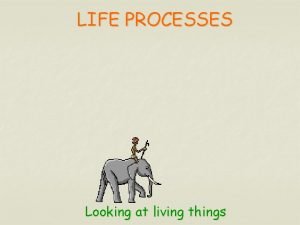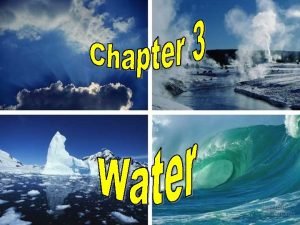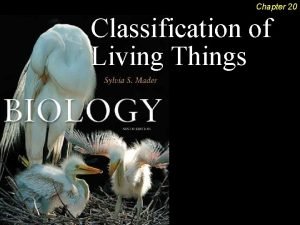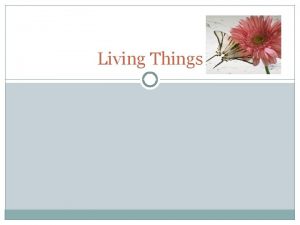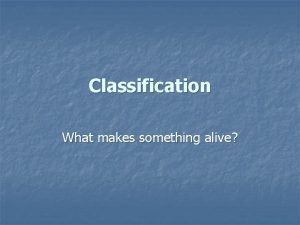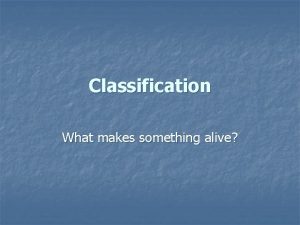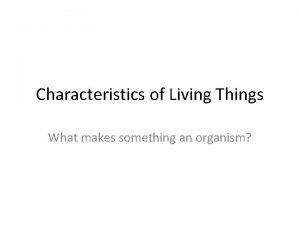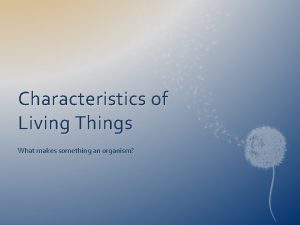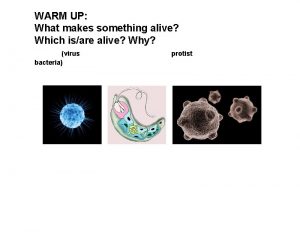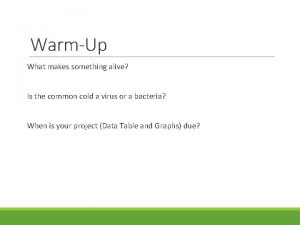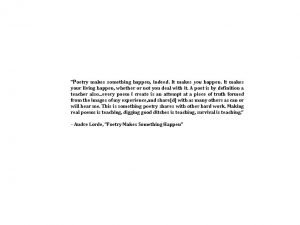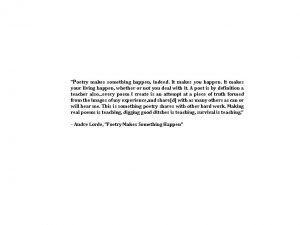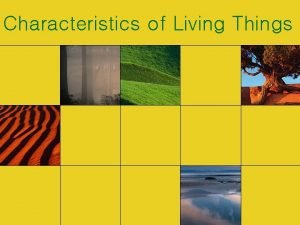What makes something alive What are living things





















































- Slides: 53

What makes something alive ?

What are living things? There are certain criteria that determine if something is living. Do ALL 9 criteria have to be met? Yes, ALL 9 criteria must be met.

Organism l Anything that possesses all of the following characteristics of life. l Living things R-CHARGEED !!

R - eproduce All living things produce offspring. Making copies of individuals by genetic transfer, sexually or asexually.

C - ells -Living organisms show an orderly structure (made up of cells) Cross-section of worm Examples: Leaf Centipede

H - omeostasis The ability to maintain internal conditions separate from an outside environment. Example: The human body maintains an average temperature of 98. 6 ºF.

A - dapt to the environment R - espond to stimuli A living organism will respond to an environmental condition called a stimulus. An adaptation is any characteristic of an organism that improves its chances of surviving in its environment A plant growing in a specific direction due to a light stimulus.

Living things change l -living things interact with the environment, and adjust to their surroundings l -environment- biotic (living) and abiotic (nonliving) factors that an organism must constantly interact with (air, water, temperature, other organisms, etc. )

G - rowth D - evelopment l Getting Bigger / Increasing material l All of the changes that take place during the life of an organism. Maturing. Growth rings in a tree Amoeba absorbing nutrients

E - energy Metabolism. Chemical and energy transformations. All organisms need energy for all life activities. Even thinking requires a considerable amount of energy. Transforming glucose into ATP for energy (to do work).

E - evolve The gradual accumulation of adaptations due to environmental stimuli. (Organisms with more suitable adaptations are more likely to survive and reproduce) Example: Owls, and other nocturnal animals have evolved large eyes for better night vision.

Alright, let’s see how well you paid attention Review the lab findings

Classify the fetal pig Alive 2. Dead but once alive 3. Never alive 4. Product of a living thing 1. 1 2 3 4 5 6 7 8 9 10 21 22 23 24 25 26 27 28 29 30 11 12 13 14 15 16 17 18 19 20

How did you know? ? ?

Classify the fish Alive 2. Dead but once alive 3. Never alive 4. Product of a living thing 1. 1 2 3 4 5 6 7 8 9 10 21 22 23 24 25 26 27 28 29 30 11 12 13 14 15 16 17 18 19 20

How did you know? ? ?

Classify the conch shell Alive 2. Dead but once alive 3. Never alive 4. Product of a living thing 1. 1 2 3 4 5 6 7 8 9 10 21 22 23 24 25 26 27 28 29 30 11 12 13 14 15 16 17 18 19 20

How did you know? ? ?

Classify the grasshopper Alive 2. Dead but once alive 3. Never alive 4. Product of a living thing 1. 1 2 3 4 5 6 7 8 9 10 21 22 23 24 25 26 27 28 29 30 11 12 13 14 15 16 17 18 19 20

How did you know? ? ?

Hedgehog! Alive 2. Dead but once alive 3. Never alive 4. Product of a living thing 1. 1 2 3 4 5 6 7 8 9 10 21 22 23 24 25 26 27 28 29 30 11 12 13 14 15 16 17 18 19 20

How did you know? ? ?

Classify Plant Alive 2. Dead but once alive 3. Never alive 4. Product of a living thing 1. 1 2 3 4 5 6 7 8 9 10 21 22 23 24 25 26 27 28 29 30 11 12 13 14 15 16 17 18 19 20

How did you know? ? ?

Classify the cotton Alive 2. Dead but once alive 3. Never alive 4. Product of a living thing 1. 1 2 3 4 5 6 7 8 9 10 21 22 23 24 25 26 27 28 29 30 11 12 13 14 15 16 17 18 19 20

How did you know? ? ?

Classify the wood block Alive 2. Dead but once alive 3. Never alive 4. Product of a living thing 1. 1 2 3 4 5 6 7 8 9 10 21 22 23 24 25 26 27 28 29 30 11 12 13 14 15 16 17 18 19 20

How did you know? ? ?

Classify the synthetic sponge Alive 2. Dead but once alive 3. Never alive 4. Product of a living thing 1. 1 2 3 4 5 6 7 8 9 10 21 22 23 24 25 26 27 28 29 30 11 12 13 14 15 16 17 18 19 20

How did you know? ? ?

Classify the candle Alive 2. Dead but once alive 3. Never alive 4. Product of a living thing 1. 1 2 3 4 5 6 7 8 9 10 21 22 23 24 25 26 27 28 29 30 11 12 13 14 15 16 17 18 19 20

How did you know? ? ?

Classify the egg Alive 2. Dead but once alive 3. Never alive 4. Product of a living thing 1. 1 2 3 4 5 6 7 8 9 10 21 22 23 24 25 26 27 28 29 30 11 12 13 14 15 16 17 18 19 20

How did you know? ? ?

Classify the beans Alive 2. Dead but once alive 3. Never alive 4. Product of a living thing 1. 1 2 3 4 5 6 7 8 9 10 21 22 23 24 25 26 27 28 29 30 11 12 13 14 15 16 17 18 19 20

How many characteristics of life must an organism possess to be considered alive? 1 3 5 2 and a half All of them 1. 2. 3. 4. 5. 1 2 3 4 5 6 7 8 9 10 21 22 23 24 25 26 27 28 29 30 11 12 13 14 15 16 17 18 19 20

All of the following are characteristics of life except… Organized Grow and Develop Adapt Maintain internal conditions Move Reproduce 1. 2. 3. 4. 5. 6. 1 2 3 4 5 6 7 8 9 10 21 22 23 24 25 26 27 28 29 30 11 12 13 14 15 16 17 18 19 20

1. 2. 3. 4. 5. 6. Which of the following characteristics of life are not required for an organism to survive but instead to ensure survival of an entire species? Organized Grow and Develop Adapt Maintain internal conditions Move Reproduce 1 2 3 4 5 6 7 8 9 10 21 22 23 24 25 26 27 28 29 30 11 12 13 14 15 16 17 18 19 20

How are living things organized? There are various levels of organization: Let’s start small and get bigger.

1) Atoms are the smallest unit of matter that have the chemical properties of a particular element. Examples: Carbon, Hydrogen, Oxygen…

2) Molecules that are the small building blocks from which larger molecules are made. Examples: Glucose Amino Acid Water

3) Macromolecules Large molecules consisting of many subunits. Examples: Protein Cellulose

4) Organelles Specialized structures inside of a cell. Examples: Mitochondria Cell Membrane

5) Cells The smallest unit of biological organization that biologists consider alive. Example:

6) Tissue A group of distinct and similar cells that carry out a specific set of functions. Examples: Muscle Skin

7) Organ Groups of tissues organized together to carry out a particular set of functions. Examples: Brain Stomach

8) Organ System Groups of organs that function together to carry out broad sets of functions. Example:

9) Organism (or individual) Individual that has its own distinct existence as a complex, reproducing unit. Examples:

10) Population Group of freely interacting and breeding individuals of the same species. Examples: School of fish Herd of Zebra

11) Community Populations of different species living and interacting together in a distinct area. Example: Marine community

12) Ecosystem Distinguishable groups of species and the abiotic (non-living) components of the environment with which the living creatures interact. Examples:

13. ) Biome l Geographically defined area based on climate and environmental conditions.

14. ) Biosphere l I’m sure you can figure this one out!
 Jesus is alive forevermore
Jesus is alive forevermore What makes something alive?
What makes something alive? What makes something alive biology
What makes something alive biology Antigentest åre
Antigentest åre What makes something living
What makes something living He's alive he's alive frankenstein
He's alive he's alive frankenstein Blue things
Blue things What is the smallest living unit in the body
What is the smallest living unit in the body All living things have seven life processes
All living things have seven life processes Are protozoa alive
Are protozoa alive Stresses movement makes the viewer feel alive in the moment
Stresses movement makes the viewer feel alive in the moment Alive but not living
Alive but not living Theme vs topic
Theme vs topic Symbols can represent concrete things
Symbols can represent concrete things When something represents something else
When something represents something else It explains how something works and why something happens
It explains how something works and why something happens Something old something new poem
Something old something new poem The room is an oven figurative language
The room is an oven figurative language Smart is not something you are
Smart is not something you are Something that describes something
Something that describes something What makes something biotic
What makes something biotic What makes something newsworthy
What makes something newsworthy What makes something a eukaryote
What makes something a eukaryote Whats historical significance
Whats historical significance Carbonyl group electrophile
Carbonyl group electrophile How do you know if something is living
How do you know if something is living What makes a living thing
What makes a living thing Is a candle living or nonliving
Is a candle living or nonliving Living non living dead
Living non living dead What make things visible
What make things visible Living things 20
Living things 20 Living things mod
Living things mod How living things obtain energy worksheet answers
How living things obtain energy worksheet answers Living things grow
Living things grow Six characteristics of living things
Six characteristics of living things Interactions among living things
Interactions among living things Do plants move on their own
Do plants move on their own Living things use carbohydrates for
Living things use carbohydrates for Living things meaning
Living things meaning Things that grow and change
Things that grow and change Living things
Living things A genus is subdivided into smaller groups called
A genus is subdivided into smaller groups called Living things definition
Living things definition Parasitism
Parasitism Six characteristics of living things
Six characteristics of living things Organisms
Organisms Classification of living things table
Classification of living things table Images of multicellular organisms
Images of multicellular organisms Classifying living things lesson 1 answer key
Classifying living things lesson 1 answer key Looking at living things
Looking at living things What part of the plant carries and protects the seed
What part of the plant carries and protects the seed Why is water important to living things
Why is water important to living things Characteristics of living things ppt
Characteristics of living things ppt Categories of living things
Categories of living things


